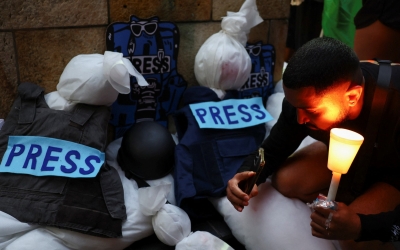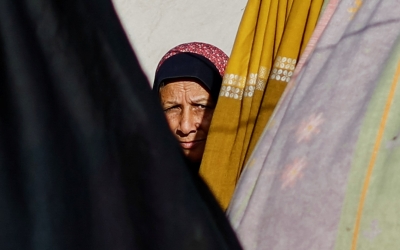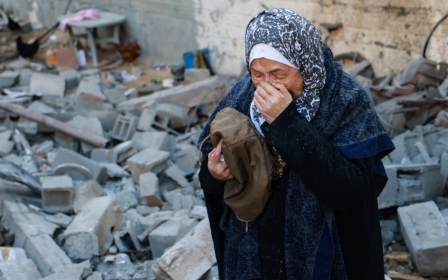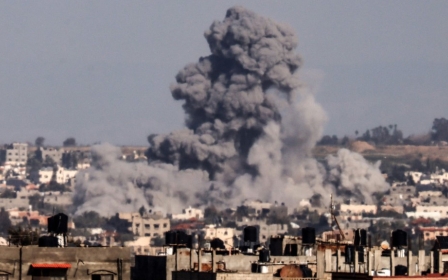War on Gaza: Palestinians in Rafah run out of shelters as Israel threatens assault

A few hundred metres from the Rafah border fence with Egypt, dozens of Palestinian families set up tents as a "last resort" as they sought refuge from the Israeli bombardment of the Gaza Strip after having to move multiple times from their homes and previous shelters.
But many are now considering yet another displacement as Israel threatens a military operation in the border town Rafah, which is now sheltering more than half of Gaza's two million residents.
In the Philadelphi Corridor, a 14km stretch of land along the border between the Gaza Strip and Egypt, Saleh Razaina has taken shelter in a tent after he was displaced for the sixth time since the beginning of Israel's attack on 7 October.
He and his family "have been drained physically and mentally" trying to find a safe place to stay.
"I came from Jabalia [in the northern Gaza Strip] and have sought refuge in different places from the north to the south, in Gaza City, Deir al-Balah, Khan Younis, and now we are here in Rafah. A few days after we arrived, Israel started threatening to attack Rafah," the 42-year-old father of four told Middle East Eye.
New MEE newsletter: Jerusalem Dispatch
Sign up to get the latest insights and analysis on Israel-Palestine, alongside Turkey Unpacked and other MEE newsletters
"In the first five times we were displaced, I stayed with relatives and friends in their homes. But here in Rafah, I do not know anyone, so I did not have a choice but to stay in a tent along with my wife, children, and mother.
"I do not know what I will do or where I will carry my elderly mother and children if they order us to move again."
For the past week, Israel has intensified its aerial attacks on Rafah, launching dozens of deadly air strikes on densely populated neighbourhoods and residential buildings.
According to Save the Children, more than 1.3 million people, including 610,000 children, are trapped in Rafah, which constitutes less than one-fifth of Gaza's total land mass.
With nowhere else to go, many people, who have already been displaced several times, say they would not leave their shelters if Israel starts a ground invasion in Rafah.
"I am not going anywhere else; I have already been displaced six times so far. This is the last place we can reach," Razaina said.
"We have come to the border area with Egypt because we thought it would be the safest place, the last place where Israel would push the residents. Now it is not possible to push them any farther, it is not possible for us to move anywhere else. We will only move from here to the grave. This is our last resort."
'They followed us here and bombed us'
In a tent next to Razaina's, Om Jehad Zaqqout, originally a resident of Tal al-Zaatar in the northern Strip, stays with her extended family, including her children, grandchildren and in-laws.
Every home she took shelter in during the attack was bombed and demolished, she said. But since coming to Rafah, she added, Israeli air strikes "have not stopped near the tents".
'It is not possible for us to move anywhere else. We will only move from here to the grave. This is our last resort'
- Saleh Razaina
"This is the third time that we have been displaced. The first time was from our home when it was targeted. We fled to our relatives' home. Their home was also targeted, so I went to my family's home. This too was bombed. The third time, we were displaced to Nusairat [in the central Gaza Strip], the Israelis then invaded [the area], and we came here," Zaqqout told MEE.
"Our home was demolished, my mother was martyred, my nephew was martyred, my husband's nephews were martyred, and we came here because the [Israelis] told us to leave and that the south was safe.
"We came to the south, near the fence, and they followed us here and bombed us. [Members of] our family were martyred here."
On Thursday, the United States warned that an Israeli military action in Rafah, conducted without careful planning or consideration, would result in a "disaster".
State Department deputy spokesperson Vedant Patel told reporters: "We would not support the undertaking of something like this without serious and credible planning as it relates to the more than a million people who are sheltering there, as well as without considering the impacts on humanitarian assistance and the safe departure of foreign nationals."
The comments came one day after Israeli Prime Minister Benjamin Netanyahu said he had ordered the Israeli military to prepare to operate in Rafah.
Zaqqout said: "We came to the border fence, where next would we go? There is no place after the fence. There is no safety in Rafah. They are starting to launch missiles on us, and we are staying in tents. When they bomb [nearby places], wouldn't [shrapnel] reach us?"
Although her home in Gaza was completely demolished, Zaqqout still wants to return there and "set up a tent on its rubble".
"No country cares, they are just watching. We do not want aid; we want to return to our homes and continue our lives there. We are struggling here. Only God knows how we are living here through this cold."
'Nowhere to go'
Hajar Srour, 52, a resident of Khan Younis, a city adjacent to Rafah, had opened her home for dozens of displaced relatives before they all had to leave it when the attacks intensified.
"Residents of the north were [taking shelter] with us. Our house consists of four floors, each floor housed at least 50 individuals. Every time bombing occurred, we ran and went down the street. We hid in neighbours' homes for two or three hours until the bombing stopped," she said.
'We came to the south, near the fence, and they followed us here and bombed us. [Members of] our family were martyred here'
- Om Jehad Zaqqout
"But then the Israelis said we had to leave Khan Younis. We wanted to leave, but we were thinking where we would go with this number of people. So, we were dispersed. Some carried their clothes, some did not, some carried nothing with them.
"Quadcopters were hovering and opening fire. We got in cars, and they continued to open fire at us. We did not know whether we would survive or not."
Srour is concerned that, after the Israeli military finishes their extensive operation in Khan Younis, they might order families in displacement camps to leave again. However, like most displaced Palestinians, she too does not know where they would go.
Both Khan Younis and Rafah were previously designated as safe zones where residents were ordered by the Israeli military to take shelter.
"We arrived near the border fence with Egypt. But now what's next? They will finish Khan Younis [and come to Rafah]. Where would we go then? Here in Rafah, we are around 1.5 million displaced people," Srour told MEE.
"There is no one we can go to. There is no hope, the Israelis left us no choice. They are not leaving us hope to say that we may go back home tomorrow or the day after."
'Scared every single minute'
Haitham Jerjawi, 37, said he and his family left for Rafah to seek shelter from the intense bombardment of Khan Younis, only to be met with "more horrors"
"We first went to Maan School [in Khan Younis]. There, we stayed for a couple of days before we were told to go to Rafah. We did. We came to Rafah and found horrors and shelling here," he said.
"We are already besieged and devastated, and above all of this, we have reached a point where we are under the shelling. We are scared every single minute. Our hearts are not made of iron or stone."
Jerjawi told MEE that he, his wife, and children "prefer death" over another displacement.
"Where would we go? What place would we reach? We are moving from one area to another along with our children, who are horrified," he said.
"We will either stay here until this war comes to an end, or they will kill us, and we would finally rest in peace."
This article is available in French on Middle East Eye French edition.
Middle East Eye delivers independent and unrivalled coverage and analysis of the Middle East, North Africa and beyond. To learn more about republishing this content and the associated fees, please fill out this form. More about MEE can be found here.







